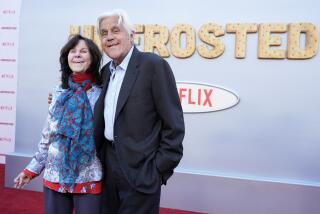A Couple’s Brave Struggle for Survival
- Share via
“Saving Milly” is both a love story and a horror story.
Love, because the relationship between the author, an Ivy League graduate and Washington political commentator of long standing, and his half-Mexican, half-Jewish wife out of the Chicago inner city, has been a romantic dream.
Horror, because after 20 years of marriage, she contracted Parkinson’s disease, and since that time, 13 years ago, has gone downhill. Soon after this book was released, Millicent Martinez Kondracke had to go on a feeding tube, an eventuality the couple had long dreaded. “She is now just fading away by centimeters,” Morton Kondracke said last week. “There’s less Milly there every day.”
Beyond an account of their life together and fighting Parkinson’s together, this passionately honest book tells how Kondracke gradually became, besides a journalist, a forceful advocate, along with Milly, for greater spending on Parkinson’s research. As he relates in his book, he personally accosted two presidents, Bill Clinton and George W. Bush, to plead for their support for a doubling of the National Institutes of Health budget, a goal still not attained.
An outstanding aspect of “Saving Milly” is its trenchant examination of the politics of medical research funding, with the competition that goes on between AIDS, breast cancer, Parkinson’s and other brain research, with adherents of each jealously guarding their places in the line for money. And, as students of government know, it is not enough for Congress to authorize the expenditures; they must be specifically appropriated, and there is often many a slip between the cup of intention and the lip of consummation.
Parkinson’s is a disease that has variations and follows different courses with different people. With some, it progresses more rapidly and more devastatingly than others. As Milly found out, a third of Parkinson’s victims have a variation known as “Parkinson’s-plus,” and she is one of them.
“No one knows exactly what it is, what causes it, or how to treat it,” Kondracke writes. “One definite Parkinson’s-plus symptom--and the most dangerous to Milly--is loss of balance.” She fell all the time, as the disease progressed, and even with the greatest care and finest equipment, this still occurred. Later, doctors concluded that even beyond Parkinson’s-plus, Milly also has Shy-Drager syndrome, also known as multi-system atrophy, under which her speech became increasingly unintelligible.
There are various brain operations that can be undertaken to try to relieve Parkinson’s symptoms, very protracted and grim in nature, and it sometimes seems in this book that Milly has tried them all. They worked for some people, but for the most part, not for her. After an operation lasting more than 12 hours, some of which Milly had to be conscious for, “It remained all too obvious that the surgery had done Milly little good at all and might have done harm.”
And yet, overall, her story in “Saving Milly” is surprisingly upbeat at other points. The Kondrackes have wonderful friends. They have made many new alliances and done great things in their struggle for research funding. And the very struggle with the disease itself has been, in its way, uplifting.
“Milly’s diagnosis changed me,” Kondracke writes. “When it became clear in 1988 that she had Parkinson’s, I said to myself, ‘This is one thing in your life you are going to do right.’ I meant that I was determined to be a loving husband and to help Milly fight the disease. I certainly did not want to stop being professionally successful, but I decided that my career was now secondary as the purpose of my life.”
Milly, too, has been indomitable in her fight for life. She remains, in important ways, the same person Kondracke so wisely married 34 years ago, after having erroneously concluded at first, “She did not fit my life’s plan. ... I figured that the person I planned to be someday should have a Vassar or Wellesley graduate for a wife, or possibly an heiress.” Fortunately, love changed his mind. The young woman from Chicago’s Roosevelt University, the daughter of two Communists, proved infinitely more suitable.
More to Read
Sign up for our Book Club newsletter
Get the latest news, events and more from the Los Angeles Times Book Club, and help us get L.A. reading and talking.
You may occasionally receive promotional content from the Los Angeles Times.









